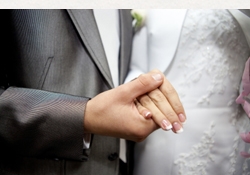 When admiring a monument or memorial, it’s helpful to know some key facts about symbolism. In previous posts, we’ve explored significant symbols and their meaning as well as religious symbols.
When admiring a monument or memorial, it’s helpful to know some key facts about symbolism. In previous posts, we’ve explored significant symbols and their meaning as well as religious symbols.
Everything on a monument has some degree of significance to the family or their heritage. Things like religious symbols, colors of granite, and even photos can help someone personalize a memorial in profound ways. However, there are usually less obvious elements of significance and symbolism.
For example, in the companion memorial below, you’ll notice that Harold, the husband, is on the left side. Harold’s wife, Alice, is on the right.

Some believe this arrangement is no accident. Often, you’ll find husbands are placed on their wife’s right side. One theory is that long ago husbands decided their wives belonged on their left side, the side closest to their heart. Other theories hold this placement is a reflection of a couple’s wedding day. When walking down the aisle, the man is traditionally standing to the right of his bride.
This arrangement is also seen in Western culture when husbands wear their wedding band on their left hand. The fourth finger (or ring finger) was thought to have a direct vein to the heart. This vein was literally known as the "vena amoris” or "vein of love”.

In the above memorial, you’ll notice two groupings of gold stars. Notice that there are 4 stars on the left and 3 on the right. Again, this placement was no accident. This represents the four sons and three daughters this person had.
So the next time you find yourself appreciating a husband and wife’s memorial, you can look for examples of men being represented on the left and women on the right.

